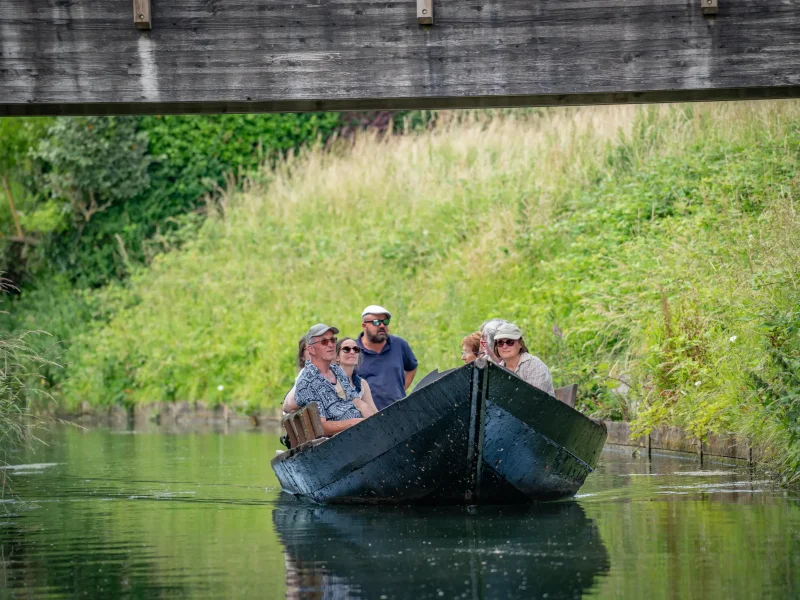The bacôve originates from the Middle Ages. It is derived from the cog, a medieval river and coastal transport vessel.

Set off to discover the bacôve, the large traditional boat of the Marais Audomarois. A symbol of this UNESCO World Heritage site, this wooden boat preserves an ancestral craft passed down since the Middle Ages. In the past, market gardeners used it to transport their harvests through the canals, especially the famous cauliflower of the marsh.

The bacôve is a large traditional boat measuring approximately 9.5 meters long and 2 meters wide. With a flat bottom and no rudder, it was perfectly suited to the narrow and shallow canals of the Marais Audomarois.
Historical capacity: up to 3.5 tonnes of goods
Current use: up to 12 passengers for guided tours
Material: solid oak, hand-caulked
At the Maison du Marais, you can board a bacôve for a peaceful ride and discover this unique landscape, classified as a UNESCO Biosphere Reserve.
The bacôve originates from the Middle Ages. It is derived from the cog, a medieval river and coastal transport vessel.

A true "truck of the marsh," it was used to transport goods, wood, stones, and especially cauliflowers, a specialty of Saint-Omer.
Before the 1970s, the Marais Audomarois had neither roads nor bridges; the bacôve was essential for all transport.
From 1972 onwards, roads and bridges were built in the marsh, making the bacôve less used by market gardeners, but it remained a symbol of Audomarois heritage.
Each bacôve is much more than a simple boat: it is a work of art crafted using skills passed down since the Middle Ages.
This traditional boat from the Marais Audomarois is almost entirely handmade, following the pure tradition of naval carpenters.
Solid oak wood is selected for its strength, durability, and natural resistance to moisture.
It forms the hull and frames, ensuring the bacôve’s longevity, sometimes lasting several decades when well maintained.
The oak planks are cut locally and carefully chosen for both sturdiness and aesthetics. Each bacôve is unique, crafted according to traditional methods.
Construction begins by shaping the planks using flame bending: heat softens the wood, which is then curved to match the hull’s characteristic shape.
Final assembly includes planking on the frames, the stem, and forged iron nails. Once the planks are fixed, caulking is done using flax fiber and traditional putty to ensure perfect watertightness. Building a complete bacôve takes nearly six weeks of artisanal work.
This handcrafted process produces a stable boat, ideal for navigating the narrow, shallow canals of the marsh, faithful to age-old techniques.
The bacôve is a traditional Flemish flat-bottomed boat without a rudder (Wikipedia). Its hull has 18 frames, 8 reinforced, providing strength and stability. The planking meets the stem at the bow and stern, improving glide on water. Each plank is then caulked in the traditional way with flax fiber and natural tar for watertightness.
The bacôve tradition is now preserved by the Boat Makers of Saint-Omer. These passionate artisans continue the skills and techniques inherited from their predecessors, in a workshop at the heart of the marsh, serving as a place for construction, restoration, and knowledge transfer.
Historically, the bacôve was the “truck” of the Marais Audomarois: transporting stones, construction wood, farm equipment, and vegetables, especially the famous cauliflowers. As long as the marsh had no roads or bridges, it was the only transport option for market gardeners. Only after the large land consolidation (1972–1984) did the use of the bacôve and its smaller sister, the escute, become almost unnecessary (Wikipedia). Until the 1970s, children and postmen used the bacôve to go to school or deliver mail.
Boarding a bacôve means diving into the heart of the Saint-Omer Marsh and experiencing an authentic, immersive adventure. These traditional boats, designed to glide gently over calm waters, allow you to discover the marsh from a unique perspective.
At the Maison du Marais, our passionate guides share local anecdotes and legends. You will learn why the bacôve remains a living symbol of Saint-Omer’s heritage today.

The bacôve is not only a symbol of historical transport in the marsh, but it also plays a central role in the Saint-Omer Nautical Parade, a major cultural and festive event. Every year, the marsh waters come alive with this parade of decorated boats, where tradition meets creativity.
During the parade, the bacôve serves as a floating platform for floats and decorations, allowing participants to parade on the water while staying true to the authentic spirit of the marsh. Its great stability and flat bottom make it the ideal vessel for carrying heavy loads or decorative structures while navigating slowly along the canals.
Participating in the nautical parade aboard a bacôve means experiencing Audomarois tradition from the inside: admiring costumes, listening to music, and feeling the living history of this unique territory. For visitors, it is also a rare opportunity to discover the marsh and its river heritage from a festive and immersive perspective.
The bacôve is a large, flat-bottomed traditional boat, typical of the Marais Audomarois, used since the Middle Ages to transport goods and vegetables.
The bacôve carried the heavy loads of the marsh: stones, wood, and cauliflower, before the appearance of roads and bridges.
Yes! At the Maison du Marais, you can board a bacôve for an authentic ride and discover this living heritage.
Approximately 9.5 m long, 2 m wide, up to 12 passengers or 3.5 tons of goods in the past.
Visit our dedicated page or contact the Maison du Marais to book your bacôve outing.